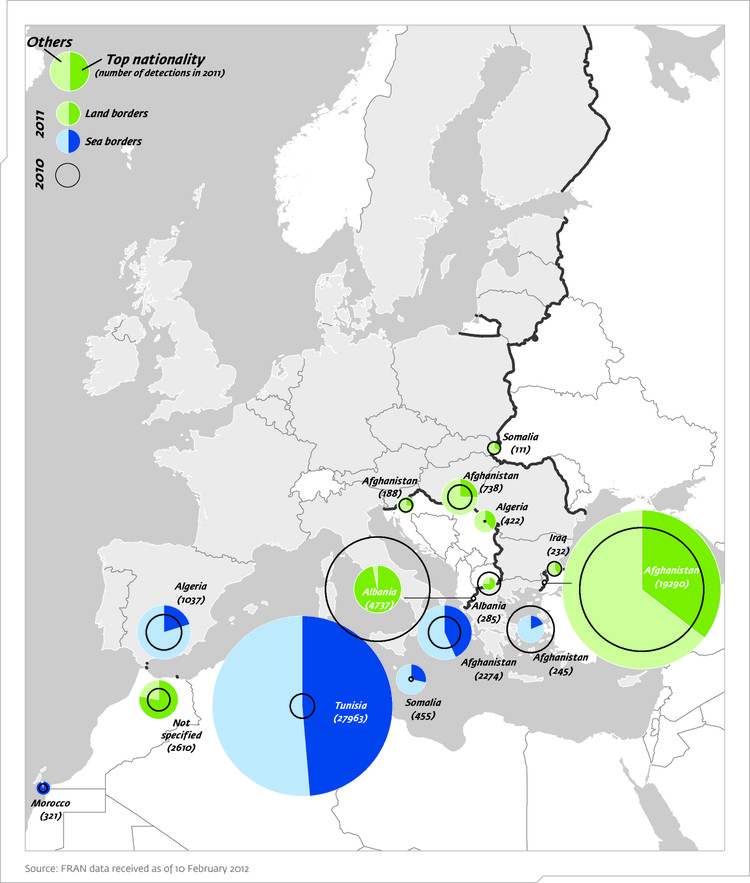Frontex published its Annual Risk Analysis (ARA) for 2012 on April 19. The document, available through the Frontex website, presents an analysis of events related to border control as well as to illegal border crossing and different forms of cross-border crime during 2011. Developed together with those Member State border authorities comprising the Frontex Risk Analysis Network (FRAN), ARA 2012 presents the main trends of last year along with probable future developments and recommendations for action. The six key indicators of irregular migration used by FRAN are:
1) Detections of illegal border-crossing,
2) Refusals of entry,
3) Detections of illegal stay,
4) Asylum applications,
5) Detections of facilitators, and
6) Detections of forged documents.
The 2012 edition also includes data on return operations for the first time as a seventh indicator.
Routes and trends
In terms of migration flows, the outstanding events of 2011 were the political upheavals in North Africa and the Arab world, commonly dubbed the Arab Spring. Flows resulting from these events caused a swelling of detections of illegal border-crossing along the external borders of EU Member States, rising sharply (by 35%) from approximately 104 000 in 2009 and 2010 to nearly 141 000 in 2011.
This increase is mostly due to the fact that more than 64 000 detections were reported in the Central Mediterranean area, compared to only 5 000 in 2010. This surge was triggered by political changes in Tunisia and sustained by the departure of many sub-Saharan African migrants from Libya. However, despite these dramatic surges, and the fact that at 20%, Tunisian nationals constituted the commonest single nationality, the countries of origin in second and third position were Afghanistan (16%) and Pakistan (11%). Afghans and Pakistanis constituted 25% and 3.7% respectively of all detections of illegal border crossings in 2010.
While the most dramatic development was undoubtedly the re-opening of the Central Mediterranean route, the second hot-spot for illegal entry remained the Eastern Mediterranean route, specifically at the land border between Greece and Turkey. Here, more than 55 000 detections were recorded in 2011, representing a 12% increase on the previous year, and the number of detections increased steadily throughout the year.
Migrants entering through Greece tended to transit through the Western Balkans, or travel directly from Greece to Italy. Looking ahead, the border between Greece and Turkey is very likely a hot spot for illegal entry. More and more migrants are expected to take advantage of Turkish visa policies and an increasing number of flights, to transit through Turkish air borders and subsequently attempt to enter the EU illegally.
Greece also saw the largest drop in illegal entries; at its border with Albania. Once one of the main entry points of irregular migration, detections at this border section plummeted from 2010 figures (by 85% from almost 35 300 to just 5 270) following the introduction of a visa-free regime for Albanians on 21 December 2010. The period consequently also witnessed a leap in refusals of entry to Albanians at the land border with Greece, at the Italian sea border, and at UK air borders. Thus, Albanians ranked first in terms of refusals of entry issued in the EU as a whole, surpassing the number of Ukrainians refused entry.
Irregular migration pressure on the Western Mediterranean route also grew against the 2010 figure, with slightly fewer than 8 500 detections in 2011, representing 6% of the EU total. Most migrants on this route came from Algeria and Morocco, while the number of arrivals from sub-Saharan countries also increased.
Modes of operation
The use of forged documents to enter the EU illegally continued to be of particular concern during 2011. Incidents of travel document forgery to enter the EU were close to 9 500 in 2011, the highest level since Frontex started systematic data collection in 2009. Apart from this increase, there were also more abuses of authentic documents by unauthorised users, known as imposters. The high level of expertise needed to falsify modern documents means that such forgeries are increasingly linked to organised crime.
In response to increasingly sophisticated travel documents, there is an increase in the use of fraudulent supporting documents to obtain authentic travel papers. For example, facilitators are developing new techniques to circumvent biometric checks. This type of fraud not only enables illegal border-crossings but also affects internal security by allowing undocumented migrants to assume false identities. It is assumed that the number of detected document fraudsters increasingly under-represents the overall extent of the phenomenon, as the main focus at the national level is still on forged and counterfeit documents, rather than modes of operation involving false identities or impostors.
Looking ahead
The persistently large number of annual detections of illegal border crossing along the external borders, oscillating between 100 000 and 150 000 since 2008, has created a market for criminal organisations facilitating the movement of illegal stayers within the EU. There is an increasing risk that these secondary movements are adding to the pull factors for illegal crossings of the EU external borders.
Various austerity measures introduced throughout Member States may result in increasing disparities between Member States in their capacity to perform border controls. As a result, facilitators may be enabled to select those border types and sections perceived as more conducive to specific modes of operation. Budget cuts could also exacerbate the problem of corruption, thus increasing the vulnerability to illegal activities across the external borders.
